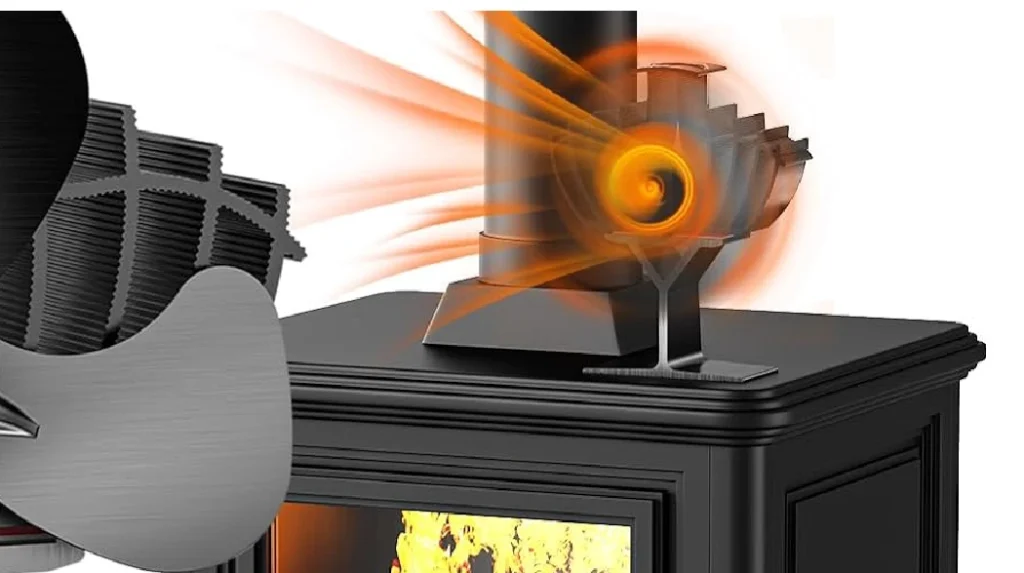Wood stove fans are highly effective in enhancing the distribution of heat from a wood stove throughout a room. They operate by using the heat generated by the stove itself to power the fan, which then circulates the warm air more evenly. This process not only improves the circulation of heat but also boosts the overall performance of your wood stove or log burner.
Wood stove fans, also known as heat-powered stove fans, work by converting the heat from the stove into electricity, which powers the fan. This ingenious design ensures that they require no external power source and operate quietly. These fans are designed to start automatically when a certain temperature is reached on the stove’s surface, making them user-friendly and efficient.
The efficiency of wood stove fans is noteworthy. Regarding the necessity of these fans, while not mandatory, they are certainly beneficial. They help in distributing warm air throughout the room more evenly and quickly than it would naturally occur. This improved distribution means that the room heats up faster, potentially leading to less fuel consumption over time.
Their effectiveness is not just limited to spreading heat but also includes potentially reducing the amount of wood used in the stove, thereby making them a cost-effective and environmentally friendly addition to wood stove heating systems.
Related: Best Wood Stove Fan- 7 Top Choices
how does a heat-powered stove fan work?
Heat-powered stove fans are an ingenious accessory for wood stoves. Their primary function is to enhance heat circulation without the need for external power sources.
The fan operates using the thermoelectric effect, where heat from the stove is converted into electricity to power the fan blades. As the stove heats up, the base of the fan, which sits directly on the stove, gets warmer. This heat is then converted into electricity through a thermoelectric module, causing the fan to spin.
The faster the stove heats, the faster the fan spins and the more air is circulated around the room. This self-regulating mechanism ensures that the fan operates efficiently and safely, distributing warm air throughout the room as the stove burns.

do wood stove fans really work?
Wood stove fans are not just a modern convenience; they are a practical addition to any wood stove heating system. When compared to natural convection or other types of fans, wood stove fans have a distinct advantage.
They are designed to distribute heat more evenly and efficiently throughout the room. Unlike traditional fans that require electricity, wood stove fans use the heat generated by the stove itself. This results in more effective heat distribution and a more comfortable living space.
Traditional electric fans might circulate air, but they don’t harness the stove’s heat similarly. Wood stove fans enhance the stove’s heating efficiency, making the room feel warmer faster and reducing the amount of wood burned.
are two stove fans better than one?
The question of whether two stove fans are better than one depends on the size and layout of the room. In larger rooms or spaces with complex layouts, using two fans can help distribute heat more evenly.
Each fan can be positioned to direct warm air to different parts of the room, ensuring a more uniform temperature throughout. This is particularly beneficial in spaces where certain areas are prone to cold spots.
However, in smaller rooms or for stoves with limited surface space, one fan might be sufficient. The key is to assess the specific heating needs of the space and choose the number of fans accordingly.
You Might Also Like: Best Wifi Temperature and Humidity Sensors- 5 Picks
Benefits of Wood Stove Fans
Improved Heat Distribution: They ensure that heat from the wood stove spreads evenly throughout the room, eliminating cold spots.
Increased Efficiency: By distributing heat more effectively, these fans can reduce the amount of wood needed for burning, making your stove more efficient.
Cost-Effective: They operate without electricity, harnessing the stove’s heat, which can help in reducing utility bills.
Eco-Friendly: By optimizing the use of the wood stove, these fans can contribute to lower emissions and a smaller carbon footprint.
Quiet Operation: Unlike electric fans, wood stove fans are remarkably quiet, adding comfort without noise disturbance.
Pros and Cons of Using Heat-Powered Stove Fans
Pros:
- Enhances heat circulation
- Reduces fuel consumption
- Eco-friendly; no external power needed
- Quiet operation
- Easy to use and install
Cons:
- Limited utility in small or well-insulated rooms
- Depends on stove temperature to operate
- May not be effective in very large spaces
- Initial cost of purchase
- Requires a flat surface on the stove for placement